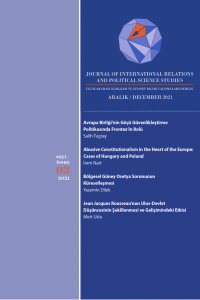Abstract
Güney Osetya, Gürcistan sınırları içerisinde yer alan ve Osetlerin yoğun olarak yaşadığı bir bölgedir. Bölgede Sovyetler Birliği döneminde dondurulmuş olan yerel milliyetçilik temelli çatışmalar ve ayrılıkçı hareketler, Birliğin çöküşü ile tekrar aktif olarak gündeme gelmiştir. Tarafların tezleri ve sorunun tarihsel altyapısına ilişkin yorum ve değerlendirmelerin yer aldığı bu araştırma kapsamında, bir ulus devletin kendi sınırları içerisinde gerçekleşen ve bölgesel nitelikli çatışmaların Avrupa Birliği ve Rusya gibi büyük güçlerin de soruna taraf olması ile nasıl küresel bir boyuta taşınmış olduğu açıklanmaya çalışılmıştır. Rusya’nın Güney Osetya sorununa aktif olarak dâhil olması ve Güney Osetya’yı Gürcistan’dan fiili olarak koparması, küresel çapta yansımaları olan bir hamle olmuştur. Yaklaşık 70.000 nüfuslu küçük bir toprak parçası olan Güney Osetya, Batılı ülkeler ve Rusya’nın tarihsel süreçte karşı karşıya geldiği pekiştirme alanlarından bir yenisi olmuştur.
References
- Alan Kültür ve Yardım Vakfı. (2018). “Güney Osetya’nın Kronolojik Siyasi Tarihi”, http://www.alanvakfi.org.tr/guney-osetyanin-kronolojik-siyasi-tarihi (Accessed 05.11.2020).
- Bozkaya, Ö. ve Eylemer, S. (2019). “Güney Kafkasya’da Ülke İçinde Yerinden Edilmiş Kişiler Sorunu: Avrupa Birliği’nin Yaklaşımı Üzerine Bir Değerlendirme”, Ankara Avrupa Çalışmaları Dergisi, 18(1), 109-142.
- Dugin, A. (2016). Rus Jeopolitiği Avrasyacı Yaklaşım (Çev. V. İmanov). İstanbul: Küre Yayınları.
- Duran, Fatma A. (2019). “Geçmişten Bugüne Osetya Sorunu” Kafkas Ajans. http://ajanskafkas.com/makale/one-cikanlar/gecmisten-bugune-osetya-sorunu/ (Accessed 30.10.2020).
- Euronews. (2018). https://tr.euronews.com/2018/08/09/-avrupa-gurcistan-ve-osetya-savasina-gerekli-tepkiyi-verseydi-rusya-kirimi-ilhak-edemezdi (Accessed 30.10.2020).
- Güner, F. (2010). Gürcü-Abhaz Çatışmaları ve Türkiye’ye Yönelik Yansımaları. Yüksek Lisans Tezi, Balıkesir Üniversitesi, Balıkesir Üniversitesi, Sosyal Bilimler Enstitüsü, Balıkesir.
- Kalkan, D. (2010). Güney Kafkasya Bölgesi’ndeki Etnik Çatışma Alanları. Yüksek Lisans Tezi, Selçuk Üniversitesi, Sosyal Bilimler Enstitüsü, Konya.
- Karabulut, B. (2011). “Rusya Gürcistan Savaşı (Beş Gün Savaşı) ve Kafkasya’da Değişen Dengeler.” Şu kitapta: Haz./Ed. Doç. Dr. Mehmet Seyfettin Erol. Küresel Güç Mücadelesinde Avrasya’nın Değişen Jeopolitiği Yeni Büyük Oyun. Ankara: Barış Kitabevi: 188-206. Mammadov, R. (2004). “Kafkasya’da Neler Oluyor?” Türk Asya Stratejik Araştırmalar Merkezi. https://tasam.org/tr-TR/Icerik/157/kafkasyada_neler_oluyor (Accessed 06.11.2020)
- Merkez Haber Alma Teşkilatı, “Ülke İstatistikleri” https://www.cia.gov.library/publications/resources/theworldfactbook/geos/gg.html (Accessed 10.11.2020)
- Nogayeva, A. (2008). “Gürcistan - Güney Osetya Sorununun Orta Asya’ya Yansımaları” Türk Asya Stratejik Araştırmalar Merkezi. https://tasam.org/tr-TR/Icerik/931/gurcistan_guney_osetya_sorununun_orta_asyaya_yansimalari (Accessed 05.11.2020)
- Oğurlu, E. (2010). “Ağustos 2008 Rusya-Gürcistan Savaşı Çerçevesinde Avrupa Birliği’nin Güney Kafkasya Politikası” Avrasya Etüdleri Dergisi, 38(2), 99-127.
- Sancaktar, C. (2008). “Kosova’dan Abhazya ve Güney Osetya’ya: Batı’nın Tutarsızlığı” Türk Asya Stratejik Araştırmalar Merkezi. https://tasam.org/tr-TR/Icerik/936/kosovadan_abhazya_ ve_guney_osetyaya_batinin_tutarsizligi (Accessed 06.11.2020).
- Taşçı, Tekin A. (2012). “İki Farklı Pencereden Güney Osetya Sorunu” (Ed.) Prof. Dr. Hasret Çomak. Uluslararası Kafkasya Kongresi Bildiriler Kitabı. Kocaeli: Kocaeli Üniversitesi Yayınları: 663-672. Yılmaz, R. (2010). “Bağımsızlık Sonrası Dönemde Rus-Gürcü İlişkileri ve Kırılma Noktaları” Avrasya Etüdleri Dergisi, 38(2), 21-42.
Abstract
South Ossetia is a region located within the borders of Georgia and densely populated by Ossetians. Conflicts based on local nationalism and separatist movements, which were frozen in the period of the Soviet Union in the region, came back to the agenda with the collapse of the Union. Within the scope of this research, which includes the arguments of the parties and the comments and evaluations on the historical infrastructure of the problem, it was tried to explain how the regional conflicts that took place within the borders of a nation-state were taken to a global dimension with the participation of great powers such as the European Union and Russia. Russia’s active involvement in the South Ossetia problem and its de facto separation of South Ossetia from Georgia has
been a move with global repercussions. South Ossetia, a small piece of land with a population of approximately 70,000, has been one of the reinforcement areas that Western countries and Russia have come across in the historical process.
References
- Alan Kültür ve Yardım Vakfı. (2018). “Güney Osetya’nın Kronolojik Siyasi Tarihi”, http://www.alanvakfi.org.tr/guney-osetyanin-kronolojik-siyasi-tarihi (Accessed 05.11.2020).
- Bozkaya, Ö. ve Eylemer, S. (2019). “Güney Kafkasya’da Ülke İçinde Yerinden Edilmiş Kişiler Sorunu: Avrupa Birliği’nin Yaklaşımı Üzerine Bir Değerlendirme”, Ankara Avrupa Çalışmaları Dergisi, 18(1), 109-142.
- Dugin, A. (2016). Rus Jeopolitiği Avrasyacı Yaklaşım (Çev. V. İmanov). İstanbul: Küre Yayınları.
- Duran, Fatma A. (2019). “Geçmişten Bugüne Osetya Sorunu” Kafkas Ajans. http://ajanskafkas.com/makale/one-cikanlar/gecmisten-bugune-osetya-sorunu/ (Accessed 30.10.2020).
- Euronews. (2018). https://tr.euronews.com/2018/08/09/-avrupa-gurcistan-ve-osetya-savasina-gerekli-tepkiyi-verseydi-rusya-kirimi-ilhak-edemezdi (Accessed 30.10.2020).
- Güner, F. (2010). Gürcü-Abhaz Çatışmaları ve Türkiye’ye Yönelik Yansımaları. Yüksek Lisans Tezi, Balıkesir Üniversitesi, Balıkesir Üniversitesi, Sosyal Bilimler Enstitüsü, Balıkesir.
- Kalkan, D. (2010). Güney Kafkasya Bölgesi’ndeki Etnik Çatışma Alanları. Yüksek Lisans Tezi, Selçuk Üniversitesi, Sosyal Bilimler Enstitüsü, Konya.
- Karabulut, B. (2011). “Rusya Gürcistan Savaşı (Beş Gün Savaşı) ve Kafkasya’da Değişen Dengeler.” Şu kitapta: Haz./Ed. Doç. Dr. Mehmet Seyfettin Erol. Küresel Güç Mücadelesinde Avrasya’nın Değişen Jeopolitiği Yeni Büyük Oyun. Ankara: Barış Kitabevi: 188-206. Mammadov, R. (2004). “Kafkasya’da Neler Oluyor?” Türk Asya Stratejik Araştırmalar Merkezi. https://tasam.org/tr-TR/Icerik/157/kafkasyada_neler_oluyor (Accessed 06.11.2020)
- Merkez Haber Alma Teşkilatı, “Ülke İstatistikleri” https://www.cia.gov.library/publications/resources/theworldfactbook/geos/gg.html (Accessed 10.11.2020)
- Nogayeva, A. (2008). “Gürcistan - Güney Osetya Sorununun Orta Asya’ya Yansımaları” Türk Asya Stratejik Araştırmalar Merkezi. https://tasam.org/tr-TR/Icerik/931/gurcistan_guney_osetya_sorununun_orta_asyaya_yansimalari (Accessed 05.11.2020)
- Oğurlu, E. (2010). “Ağustos 2008 Rusya-Gürcistan Savaşı Çerçevesinde Avrupa Birliği’nin Güney Kafkasya Politikası” Avrasya Etüdleri Dergisi, 38(2), 99-127.
- Sancaktar, C. (2008). “Kosova’dan Abhazya ve Güney Osetya’ya: Batı’nın Tutarsızlığı” Türk Asya Stratejik Araştırmalar Merkezi. https://tasam.org/tr-TR/Icerik/936/kosovadan_abhazya_ ve_guney_osetyaya_batinin_tutarsizligi (Accessed 06.11.2020).
- Taşçı, Tekin A. (2012). “İki Farklı Pencereden Güney Osetya Sorunu” (Ed.) Prof. Dr. Hasret Çomak. Uluslararası Kafkasya Kongresi Bildiriler Kitabı. Kocaeli: Kocaeli Üniversitesi Yayınları: 663-672. Yılmaz, R. (2010). “Bağımsızlık Sonrası Dönemde Rus-Gürcü İlişkileri ve Kırılma Noktaları” Avrasya Etüdleri Dergisi, 38(2), 21-42.
Details
| Primary Language | Turkish |
|---|---|
| Subjects | International Relations |
| Journal Section | Research Articles |
| Authors | |
| Publication Date | December 31, 2021 |
| Submission Date | April 19, 2021 |
| Published in Issue | Year 2021 Issue: 3 |
![]()
This work is licensed under Attribution-NonCommercial-ShareAlike 4.0 International


